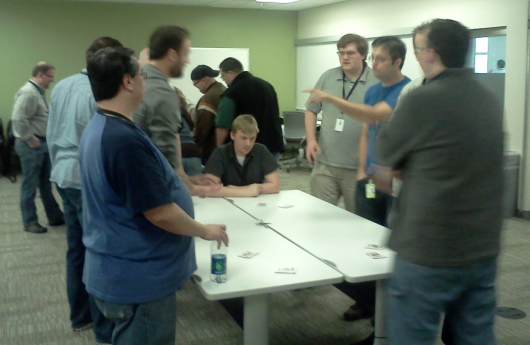Agile Games are a way for teams to learn and apply agile concepts in a fun, playful, safe environment. Play is important as it brings aliveness to our work environment that allows for creativity and our best work to flow. Games provide a safe environment where people are more open and willing to take risks and embrace change. The safety of games also allows us to talk about work… without necessarily talking about work. By playing with cards and celebrities, we are able to talk about processes and practices abstractly instead of using highly-charged and sometimes sensitive specifics. Games can lead people to discover things for themselves as they step outside of their normal workday and get a different perspective.
Several teams at Ancestry.com recently got together for an activity to play a few games to learn about agile/lean concepts like limiting work in progress, reducing waste, estimation, communication and iterating quickly.
We played Nancy Van Schooenderwoert’s Lean Workflow Design Game (presented at Agile Games 2012) and Geoff Watts’s Celebrity Prioritization (posted on Tasty Cupcakes).
For the Lean Workflow Design Game we use the task of sorting playing cards as a proxy for product development. As we go through different iterations (with retrospectives and planning), we inspect and adapt the process that our team uses. We explored concepts such as specialization, swarming, quality control and resilient processes.

Celebrity Prioritization explores how we make prioritization decisions. The players came up with names of celebrities (wrote them on index cards, one per index card) and then teams of 6-8 people had ten minutes to prioritize the celebrities for being rescued from a sinking cruise-liner. We explored prioritization criteria, the importance of different sections of the list, individual priorities, holding team members accountable and the importance of coming to a decision.
The most important part of any agile game, especially when using the game for learning, is the debrief. According to Thiagi.com, “People don’t learn from experience; they learn from reflecting on their experience.” The debrief allows participants to digest the experience, bounce ideas off each other and discover how it applies to their work. In our games, players had insights around the tradeoffs of specialization versus generalization and that a prioritization decision is better than no prioritization decision.
If your team is struggling with agile concepts or needs a jolt to continue to improve, using games to bring new ideas to a group is fun and effective!